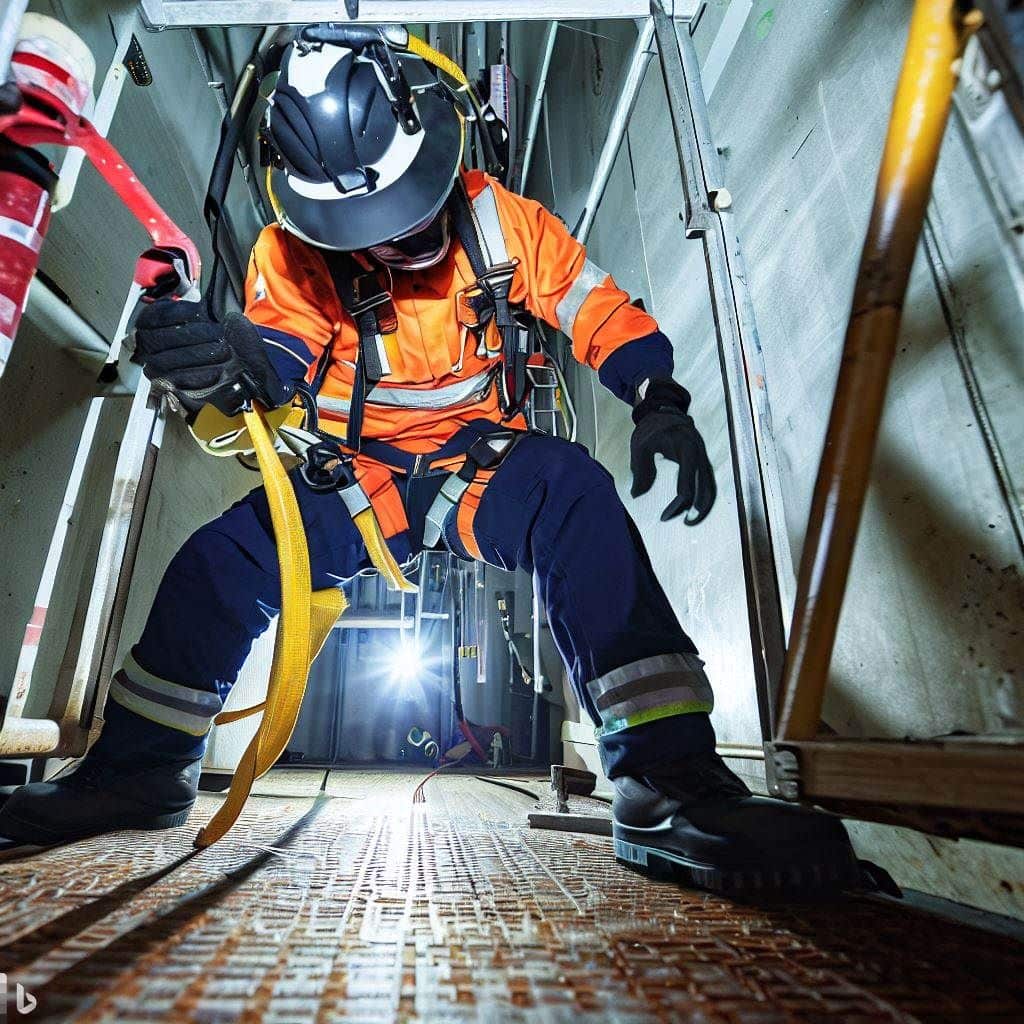Mastering Workplace Safety: Your Comprehensive Guide to OSHA Confined Space Training Online
As a safety professional, you understand the importance of ensuring that employees are well-trained and knowledgeable about the potential hazards they may encounter in their work environment. One critical area where safety training is essential is in confined spaces.
OSHA defines confined spaces as those areas with limited or restricted means of entry or exit and is not designed for continuous occupancy. These spaces can pose a significant risk to workers if not approached with caution and the proper training. This is where OSHA confined space training online comes in.
OSHA confined space training online provides workers with the knowledge and skills necessary to identify, assess, and mitigate potential hazards associated with working in confined spaces.
The training can include information on recognizing confined spaces, understanding their associated dangers, and the proper protocols to follow when working in these environments. Through this training, workers can minimize the risk of accidents and injuries, improving overall workplace safety.
In this comprehensive guide, we will explore the importance of OSHA confined space training online, the key components of this training, and how to choose the right course for your needs. We will also provide tips for completing the training and implementing workplace safety measures after completion.
Understanding Confined Spaces and Their Hazards
Before diving into the specifics of OSHA confined space training online, it’s essential to clearly understand what constitutes a confined space and its associated hazards. A confined space is an area that has limited or restricted means of entry or exit and is not designed for continuous occupancy. Examples of confined spaces include tanks, silos, storage bins, vaults, and pits.
There are several potential hazards associated with confined spaces, including:
- Hazardous Atmospheres: Confined spaces can contain hazardous gases, vapors, or fumes that can cause serious injury or death. The lack of ventilation can cause the buildup of these harmful substances, increasing the risk to workers.
- Engulfment: Workers can become engulfed by loose materials, such as grain or sand, that can fill a confined space, trapping or suffocating the worker.
- Entrapment: Tight spaces can make it difficult for workers to move or exit the area, leading to entrapment and the potential for injury or suffocation.
- Physical Hazards: Confined spaces can present physical hazards, such as slippery surfaces, sharp edges, or extreme temperatures.
- Oxygen Deficiency: The lack of ventilation in confined spaces can lead to oxygen deficiency, causing workers to become disoriented, unconscious, or asphyxiation.

The Importance of OSHA Confined Space Training Online
Given the potential hazards associated with confined spaces, workers must receive proper training to ensure their safety. OSHA confined space training online is essential for providing workers with the knowledge and skills to navigate these hazardous environments safely.
By completing OSHA confined space training online, workers can thoroughly understand the potential risks associated with confined spaces and learn how to assess and mitigate these risks. This knowledge is crucial for preventing accidents and injuries in the workplace and improving overall safety and productivity.
Moreover, OSHA confined space training online helps employers comply with OSHA regulations and standards, such as the Permit-Required Confined Spaces Standard (29 CFR 1910.146).
This standard requires employers to identify and evaluate confined spaces in the workplace, establish a permit system for entry, and provide training for employees working in confined spaces. Employers can fulfill these requirements by offering online training while providing workers with a convenient and accessible learning environment.
Key Components of OSHA Confined Space Training Online
OSHA confined space training online typically covers several key components to ensure workers have the necessary knowledge and skills to work safely in confined spaces. These components may include:
- Identifying Confined Spaces: Training should teach workers to recognize confined spaces and their potential hazards.
- Hazard Assessment: Workers must learn how to assess the specific hazards present in a confined space, such as hazardous atmospheres, engulfment, entrapment, physical hazards, or oxygen deficiency.
- Permit-Required Confined Spaces: Training should cover the requirements for permit-required confined spaces, including the permit system for entry and the roles and responsibilities of workers, supervisors, and entry attendants.
- Personal Protective Equipment (PPE): Workers should be trained on the proper use and maintenance of PPE necessary for confined space entry, such as respirators, harnesses, and lifelines.
- Emergency Response and Rescue: Training should include information on emergency response and rescue procedures in confined spaces, including communication and coordination with rescue teams.
By covering these key components, OSHA confined space training online provides workers with the comprehensive knowledge they need to safely work in confined spaces and minimize the risk of accidents and injuries.
Benefits and Advantages of Online Training
OSHA confined space training online offers several benefits and advantages compared to traditional in-person training. Some of these advantages include:
- Convenience: Online training can be accessed from any location with an internet connection, allowing workers to complete the training at their own pace and on their own time.
- Cost-Effective: Online training can be more cost-effective than in-person training, as no travel expenses or facility rental fees are involved.
- Consistency: Online training ensures that all workers receive the same information and training materials, promoting consistency in knowledge and understanding of confined space hazards and safety protocols.
- Flexibility: Online training can be easily updated and modified to reflect changes in OSHA regulations or industry best practices, ensuring workers receive the most current and relevant information.
- Recordkeeping: Many online training platforms offer built-in recordkeeping tools, making it easier for employers to track employee training and ensure compliance with OSHA requirements.
How to Choose the Right OSHA Confined Space Training Online Course
When selecting an OSHA confined space training online course, it’s essential to consider several factors to ensure the training meets your needs and complies with OSHA regulations. These factors include:
- Content: Ensure the course covers the key components of confined space training, as discussed earlier in this guide.
- Accreditation: Look for a training provider accredited or recognized by OSHA or another reputable safety organization.
- Learning Format: Choose a course that offers a learning format that best suits your needs, such as interactive modules, videos, quizzes, or other engaging learning tools.
- Instructor Support: Opt for a course that provides access to knowledgeable instructors who can answer questions and guide the training process.
- Recordkeeping: Select a course with built-in recordkeeping tools to help you track employee training and compliance with OSHA requirements.
Considering these factors, you can choose an OSHA confined space training online course that meets your needs and ensures the safety of your workers.
Tips for Successfully Completing OSHA Confined Space Training Online
To get the most out of your OSHA confined space training online and ensure successful completion, consider the following tips:
- Set a Schedule: Create a schedule for completing the training, allocating sufficient time for learning and reviewing the material.
- Take Notes: As you progress through the training, take notes on key concepts and information to reinforce your learning and aid in retention.
- Engage with the Material: Actively engage with the material by participating in interactive modules, quizzes, and other learning tools provided in the course.
- Seek Assistance: If you have questions or need clarification on any aspect of the training, contact the course instructor or support team for assistance.
- Review and Reflect: Upon completing the training, review your notes and reflect on your learning to solidify your understanding of confined space hazards and safety protocols.
Implementing and Enforcing Workplace Safety After Training
After completing OSHA confined space training online, it’s crucial to implement and enforce workplace safety measures to protect workers and maintain compliance with OSHA regulations. Some steps to take include:
- Establish a Confined Space Entry Program: Develop a comprehensive confined space entry program that outlines procedures for identifying, assessing, and mitigating confined space hazards.
- Train Additional Employees: Ensure that all employees who may encounter confined spaces receive the appropriate training.
- Conduct Regular Inspections: Inspect confined spaces to identify and address potential hazards.
- Maintain Proper Recordkeeping: Keep accurate records of employee training, confined space permits, and inspections to demonstrate compliance with OSHA requirements.
- Encourage Open Communication: Promote a culture of open communication where employees feel comfortable reporting potential hazards or concerns related to confined spaces.

OSHA Confined Space Training Online Resources and Support
Numerous resources and support options exist for individuals and organizations seeking online OSHA confined space training. Some of these resources include:
- OSHA’s Website: OSHA’s website offers a wealth of information on confined space regulations, guidelines, and training requirements.
- Online Training Providers: Several accredited online training providers offer OSHA confined space training courses with varying support and resources.
- Industry Associations: Many industry associations offer resources and support for confined space training and compliance, including the American Society of Safety Professionals (ASSP), the National Safety Council (NSC), and the Voluntary Protection Programs Participants’ Association (VPPPA).
- OSHA Consultation Services: OSHA offers free consultation services for small businesses seeking confined space training and compliance assistance.
By utilizing these resources and support options, you can ensure your organization’s compliance with OSHA confined space regulations and promote a workplace safety culture.
Conclusion: Mastering Workplace Safety with OSHA Confined Space Training Online
In conclusion, online OSHA confined space training is essential to workplace safety, providing workers with the knowledge and skills to safely navigate confined spaces and minimize the risk of accidents and injuries. By understanding the importance of this training, selecting the right course, and implementing safety measures in the workplace, you can master workplace safety and ensure compliance with OSHA regulations.
Frequently Asked Questions:
How long is OSHA confined space training online valid?
OSHA does not specify a specific timeframe for confined space training to remain valid. However, it is recommended that workers receive refresher training periodically or when there are changes in the workplace or confined space hazards.
Can I complete OSHA confined space training online on my own time?
Yes, most online training courses allow you to complete the training at your own pace and on time.
How do I know if a confined space is permit-required?
A confined space is considered permit-required if it meets the definition of a confined space and has one or more of the following characteristics: contains or has the potential to contain a hazardous atmosphere, contains a material that has the potential for engulfing an entrant, has an internal configuration that could trap or asphyxiate an entrant, or contains any other recognized serious safety or health hazard.
What are the responsibilities of an entry attendant during confined space entry?
The entry attendant is responsible for meeting entry conditions, monitoring the confined space, maintaining communication with entrants, and initiating rescue procedures if needed.
What are the consequences of noncompliance with OSHA confined space regulations?
Noncompliance with OSHA confined space regulations can result in citations, fines, and even criminal penalties in cases of willful violations that result in death or serious injury.
